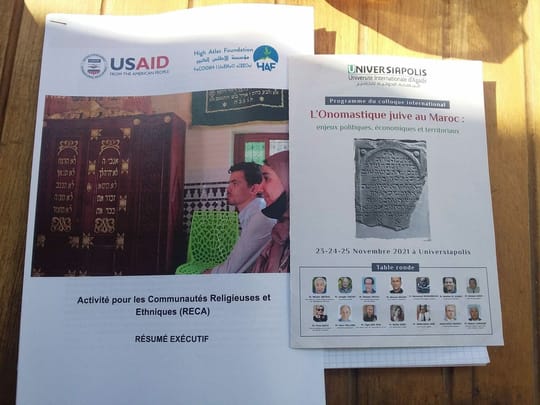Jewish Onomastics in Morocco

By Jamal Maghiouzi, Cultural Field Coordinator
On Tuesday, November 24, I had the chance to attend the first day of the conference which was held under the theme Jewish Onomastics in Morocco: Political, Economic, and Territorial Implication at Universiapolis University in Agadir. The event gathered the participation of various scholars from different parts of the world, including Morocco, Israel, Canada, France, and the United States.

Photo taken in 11/24/2021 by Jamal Maghiouzi
The conference touched upon several topics, including the importance of Jewish onomastics in the context of Morocco, the influence of Sultan’s traders/,tujjâral-sulTân, potential partnership opportunities between Morocco and Israel in the tourism sector, the historical background of mellahs, and the importance of the preservation of Morocco’s cultural and interreligious heritage.

From lef to right, Pr. Orna Baziz of Academic School of Trainings for teachers in Jerusalem, Pr. Hassan Rachik of Hassan II University in Casablanca , Pr. Ahmed Sabir of Ibn Zohr University in Agadir, Pr Mohamed Boukhrouk of Cadi Ayyad in Marrakech, Pr. Hassan Faouzi International university of Agadir/ Lorraine University, photo taken in 11/24/2021 by Jamal Maghiouzi.
Throughout the presentations and panels, the attendees discussed the historical and cultural value of mellahs, some of which existed outside of Morocco in Italy, as well as in Spain and were referred to as “Judería.” These Jewish quarters, which date back centuries ago, have become a cultural facet of some cities, as well as a major tourist attraction.
A fascinating aspect of Morocco’s rich history that the conference and its panelists focused on is the intertwining history of Amazighi and Jewish Moroccans. In an attempt to preserve such a unique heritage, an initiative of young people in Ifrane/Anti-Atlas Mountains is working toward collecting and preserving songs performed by Jews and Amazigh people in the region.
Several attendees reiterated the importance of raising awareness about Jewish Onomastics in Morocco and the need to preserve the Moroccan Jewish heritage for past and future generations. As a case in point, there are museums in Tata (Cheikh Omar museum in Aqqa/Tata) and La Maison D’Iligh (Douar Illigh, Sidi Ahmed Ou Moussa) that contain documents which attest to the presence of Jewish communities in the region. Those museums are in poor condition, and there is a growing concern that such valuable sources of information could risk being destroyed or damaged.
The conference’s aims are in line with REMA’s objectives in terms of showcasing Morocco’s untold stories of interreligious and intercultural coexistence.
Jamal Maghiouzi is a Cultural Field Coordinator for the (USAID) Religious and Ethnic Minorities Activity (REMA). He is currently based in the Taroudant province.
This article was completed with the support of the United States Agency for International Development, and the High Atlas Foundation is solely responsible for its content, which does not necessarily reflect the views of the USAID or the Government of the United States.